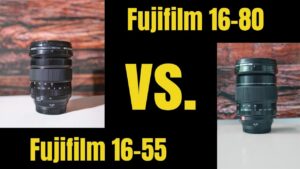Quick Facts about the Fujifilm 10-24mm F4 OIS WR Lens
- Weight: 13.6 oz/385 Grams
- Weather Sealed: Yes (There is a previous version that is not. However, it has the same optical formula.)
- Filter Size: 72mm
- Angle of View: 110 to 61.2 Degrees
- Focusing Distance: 9.4″/ 24 cm
- Max Aperture: F4
- Minimum Aperture: F22
- Image Stabilization: Yes
- Mount System: Fuji X
- Price: $999
- Zoom: Internal
Table of Contents
Introduction to the Fujifilm 10-24 F4 WR
One of two wide-angle zooms for the X-Mount, the Fujifilm 10-24 F4 OIS WR lens is a staple in most Fuji landscape photographer’s bags.
Released in 2020, this new model gained weather resistance, a marked aperture ring, and an additional stop of OIS over the previous 2014 version, the 10-24 F4 OIS.
Now, despite this lens being a wide-angle zoom, you might be wondering…..
Who is the Fujifilm 10-24 F4 for?
To put it briefly, the Fujifilm 10-24mm is the perfect lens for the hybrid shooter.
Videographers will be very happy with this lens. In my unprofessional opinion, this is Fujifilm’s best performing lens in terms of autofocus speed. (Plus, it’s Fuji’s only wide-angle lens that accepts filters without an adapter.)
Photographers will find the focal length interesting, as you will be able to get super-wide photos at 10mm (15mm FF) BUT still be able to get usable portraits at 23mm F4 (35mm FF).
To quote a famous singer, “You get the best of both worlds.”
What other Fujifilm lenses cover the 10-24 (APS-C)/15-36 (FF) equivalent?
Zooms
Sadly, there is only one other Fujifilm X wide-angle zoom, the 8-16mm F2.8. With that lens, you gain a (FULL!) stop of light along with 2 mm and some optical improvements. However, you greatly lose in the realm of filters.
The Fujifilm 8-16mm has a bulbous front, which means you are going to be purchasing a system that is inevitably more expensive and potentially incompatible with other brands. (For example, this is a filter from Adorama that shows what I mean. Just a FYI, that is NOT an affiliate link.)
If you want to read more about my gripes with Filters, please see below the prime section.
- Fujifilm XF 8-16mm f/2.8 R LM WR Lens
Primes
Within wide angle prime land, there are numerous great examples for the Fuji X-Mount. However, there is one catch. There is not a single prime lens that has OIS.
- Fujifilm XF 14mm F2.8 R Lens
- Fujifilm XF 16mm F1.4 WR Lens
- Fujifilm XF 18mm F1.4 R LM WR Lens
- 23mm F1.4 R LM WR Lens
Third Party
- Samyang/Rokinon 12mm F2 (Manual Focus)
- Viltrox 13mm F1.4

Do Lens Filters Matter?
Lens filters matter… period.
If you purchase a cheap lens filter, it could change your white balance, vignette heavily in the corners, or both!
One great example is my Freewell 2-5 Variable ND Filter. It maintains a consistent yellow cast throughout the entire frame, which is easily correctable in post-production (if you shoot in a flat color profile.)
Beyond the color shift, when I stop down to 5 stops, I introduce a rather large vignette to the image! (I work around it by using my 6-9 variable ND filter.)
There’s a cliche that “You don’t put cheap glass in front of your expensive glass.”
I agree to a point, but I also believe that a filter is the best secret investment for photographers. If you buy a good one(s), you will only have to purchase it every 5-10 years! PLUS CAMERA LENS FILTERS ARE THE ONE THING THAT IS USABLE ACROSS ALL CAMERA BRANDS
Ex. I just recently received my new UV Filter for the Fujifilm 10-24mm, which has a 72mm filter thread. However, instead of buying the 72mm UV filter, I bought the 82mm and the 72-82mm step-up ring.
When I buy my next lens, I can just buy another step-up ring instead of an entire filter!
What is a step-up ring?
A ring that allows you to adapt the filter thread size. For example a 58-82 allows you to screw your 82mm filter onto the 52mm lens hood. (That’s a sight to behold….)
What is the 10-24 Field of View
I’m not going to lie, the 10-24mm has a MUCH bigger zoom range than it first appears. (Mainly because 15mm is so wide.)
To show you what I mean check out the next two photos!
Image Quality and Sharpness Test
Please note: The following photos have been cropped from a 20.80″ x 13.87″ photo to an 8″x8″ square focused on the top-left portion.
Each one of these photos were taken with the X-T4 @1/100s with a tripod and compressed at 50% when I exported from Capture One.(Needless to say, this lens is very sharp.)
If you have any questions about why I think the wall test is subjective, let me know on Instagram, and I will get back to you!
From these findings, I have a couple of key takeaways.
- In the beginning and middle of the 10-24’s zoom range, the sharpness is excellent.
- The 16mm f1.4 is noticeably sharper.
- The image degradation starts at 20mm, but the lens does remain usable.
- All photos are sharp at F5.6, but they reach peak performance at F8.
- I hate taking photos of brick walls.
- F11 (not pictured because of space) is when this lens’s image quality starts to fall apart again. It’s not that you cannot use the images, but I don’t like it.
Fujifilm 10-24 Sample Images
Here’s what I want you to know from these sample images. With the current state of photography, it’s not about the camera or lens anymore. Good photography is entirely built on post-processing.
Portrait Bokeh Test
When it comes to bokeh, (Sorry, I didn’t want to take a picture of myself.) it is not bad… but it’s at F4.
If you need a wide-angle prime for low-light and depth-of-field, I suggest the XF 16mm f1.4, XF 18mm f1.4, or Viltrox 13mm f1.4. They would be the best options.
My advice: If you are using a wide-angle lens for portraits, shoot vertically (up-and-down) instead of horizontally. (side-to-side)
Bokeh Balls Test
When it comes to bokeh balls on the 10-24, I was satisfied. At both F4 & F5.6, we had a slight hexagonal shape. However, I found the lens construction to create serviceable results.
Fujifilm 10-24 Autofocus Video
Because we have a wide angle lens, we have a deeper field of view than something like a 50mm.
(The further you gain in a telephoto lens, the shallower the depth of field even if the aperture is the same. A 70mm F4 has a shallower depth of field than 50mm F4.)
I do think this contributes to a better autofocus experience, as I don’t have to do much to stay in focus.
The following video was shot at:
- Any Eye
- Tracking Sensitivity +2
- Autofocus Speed +3
Now, I believe that Fujifilm’s 10-24mm lens might be one of Fuji’s best performing lenses in regards to video autofocus. (Please note: I haven’t tried the 16-55 yet, and I hear wonderful things about that one.)Because of its optical design, 14 elements in 10 groups, there is not as much glass movement within the lens itself. However, the largest weakness for this lens in regards to video quality is the corner wobble.
There is a vlogging test below that shows more autofocus capabilities and the corner wobble.
Fujifilm 10-24 Photo Autofocus
Although this lens is great for video, it’s not the best for still photography. Because of the wild field of view, the autofocus will latch onto anything in the frame if you have it on continuous tracking with zone focusing.
Macro & Focusing Distance
According to the official specification sheet, the focusing distance is about 9.4 inches (24cm), and the maximum magnification ratio is only .16x too.
Because of this, I always suggest two other lenses if you want a wide angle macro lens.
My first suggestion is the 16mm f1.4. It has a focusing distance of only 5.91 inches (15cm) and a magnification ratio of .21x.
If you need something on the longer end, the 23mm f1.4 MKII has a focusing distance of 7.5 inches (19cm) and a magnification ratio of .2x.
A bonus of both of these prime lenses too is the fall-off, as the aperture contributes to creating more bokeh.
Color Accuracy
This lens produces colors in a realistic manner. If you want to see an example of color accuracy, please see the macro test above or starburst test below.
Fujifilm 10-24 Vlogging Test
I have no problem with the autofocus experience when it comes to vlogging. However, back in my #travelvlogger days, I lost autofocus twice. (And both times were my fault.)
With a field of view of 10mm (15mm FF), I set the autofocus to “only” face recognition. (I was wearing sunglasses in Greece a lot, so I figured this would be the best setting.) However, the camera lost me in the wide field of view, as somebody behind me was not wearing any glasses. That might be more of an X-T4 software problem, but there is a workaround within the camera called a focus limiter.
What is a Focus Limiter?
A focus limiter is a manual setting that YOU input that instructs the camera to only focus on subjects between two distances.
For example, when vlogging with a wide angle lens, tell the camera to only focus on subjects between 2 and 8 feet. Then, turn on face or eye detection. It will keep you in frame AND tells the AF to ignore people behind you.
As you can see in this next video, I never lost my eye.
For this vlog test, I used the camera @ 4k60. (I always shoot w/the X-T4 at 4k60 @ 200 MBPS.) And here are some things I have noticed between this vlog test and the IBIS/OIS test below.
Side Note: Because I shoot at 4k60, the X-T4 will always have a 1.18x crop. If I use digital stabilization, it crops by 1.29x.
- 10mm has a serious wobbling problem, even with the Digital Stabilization example. Speaking from experience, there is almost nothing you can do for corner wobble in post-production.
- 14mm is still wobbly. However, it isn’t “too” bad.
- The remainder of the focal lengths are smooth.
Fujifilm 10-24 OIS Test
Sunbursts/Starbursts
I was VERY impressed with the sunstars that were produced with this lens. (Also, shoutout to Switzerland for a great couple of days!)
At 10mm, we had usable sunstars starting at F8. However, starting at F16, they were just beautiful.

On the longer end, the sunstars were not horrible either!
Pros of the Fujifilm 10-24
- Perfect Travel Lens
Fujifilm has always ranked amongst my favorite camera ecosystems for travel. And to be honest, the Fujifilm 10-24mm F4 is a great example why I believe this. I have never had any problems balancing this lens on either the X-Txx or X-T lines.
It only weighs 13.6 ounces, has a 72mm filter thread, and is smaller than my hand. (Yes, seriously.) This and my X-T4 provide a great combination that is waterproof, and something I can shove in my camera bag.
Is it as inconspicuous as the 35mm F2? No. But does it look expensive? Probably. Is it easy to hide and is my travel tripod heavier? Yes.
- Weather Sealed
I took this lens to a waterfall. I’m more worried about the camera than the lens.
- Sharpness
Usually, when it comes to image sharpness, zoom lenses struggle on both the short end AND the long end. However, this one only struggles on that extreme long end! If you are planning on using this lens between 16-23mm, it might be better to purchase something like the 16-55. However, this lens is one of the best Fujifilm zoom lenses in regards to sharpness.
- Experimental Focal Length
Look, I think this camera lens is fun!

But with something this wide, you need to be careful that you don’t introduce distortion. But speaking of something this wide, there are only a few XF lenses that offer a similar field-of-view as this lens.
Cons of the Fujifilm 10-24
- Struggles in Low Light
Look, when you buy a F4 lens, you get an F4 lens. Do I wish I could shoot in low-light? Yes, but the lens is not made for that. In a dream world, I would have a 14-50 F2.0 that only weighs 1350 grams. But that isn’t realistic. What is realistic is use this lens during the day and switch to a wide-angle prime at night.
My Final Notes
If you need a Fujifilm XF wide-angle zoom, this should be your only option. It’s ability to accept circular filters, superb image quality, and good autofocus place it amongst Fuji’s best. Pair it with a telephoto zoom, and you have my favorite XF travel combo.
My Rating
Price: 4.5/5
If it was $100 cheaper, this lens would be a steal. However, you can find non weather-resistant copies for about $500 used.
Reliability: 4.5/5
I wish I could use this lens at 24mm for photography. However, this might be Fuji’s best wide-angle video lens. The OIS is a great addition, and the weather resistance provides a nice touch.
Functionality: 4/5
Is 10mm (15mm FF) too much? I will let you be the judge.
Something I learned in Europe is most buildings were built to human eye-scale. So, you will never really need anything more than 16mm (24mm), if you are focusing on architecture photography.
Style: 5/5
Well built and a nice coating of black paint. Not a huge fan of the lens hood, but I can make it work.
Total: 18/20 or 90%.

Best Washington DC Neighborhood for Photography
If you have ever lived in Washington DC, you know despite the great views, it’s a very, very tricky area to photograph in.

WorldPackers Review: My Experience in the USA
WorldPackers is an online work exchange program that offers worldwide accommodation in exchange for work. How does it compare against the others?

Fujifilm 16-55 vs 16-80mm F4
The Fujifilm 16-80mm F4 and 16-55mm F2.8 are some of the most expensive “normal” zoom lenses that Fuji makes. Is the 16-80 so bad? And is the 16-55 better?

























